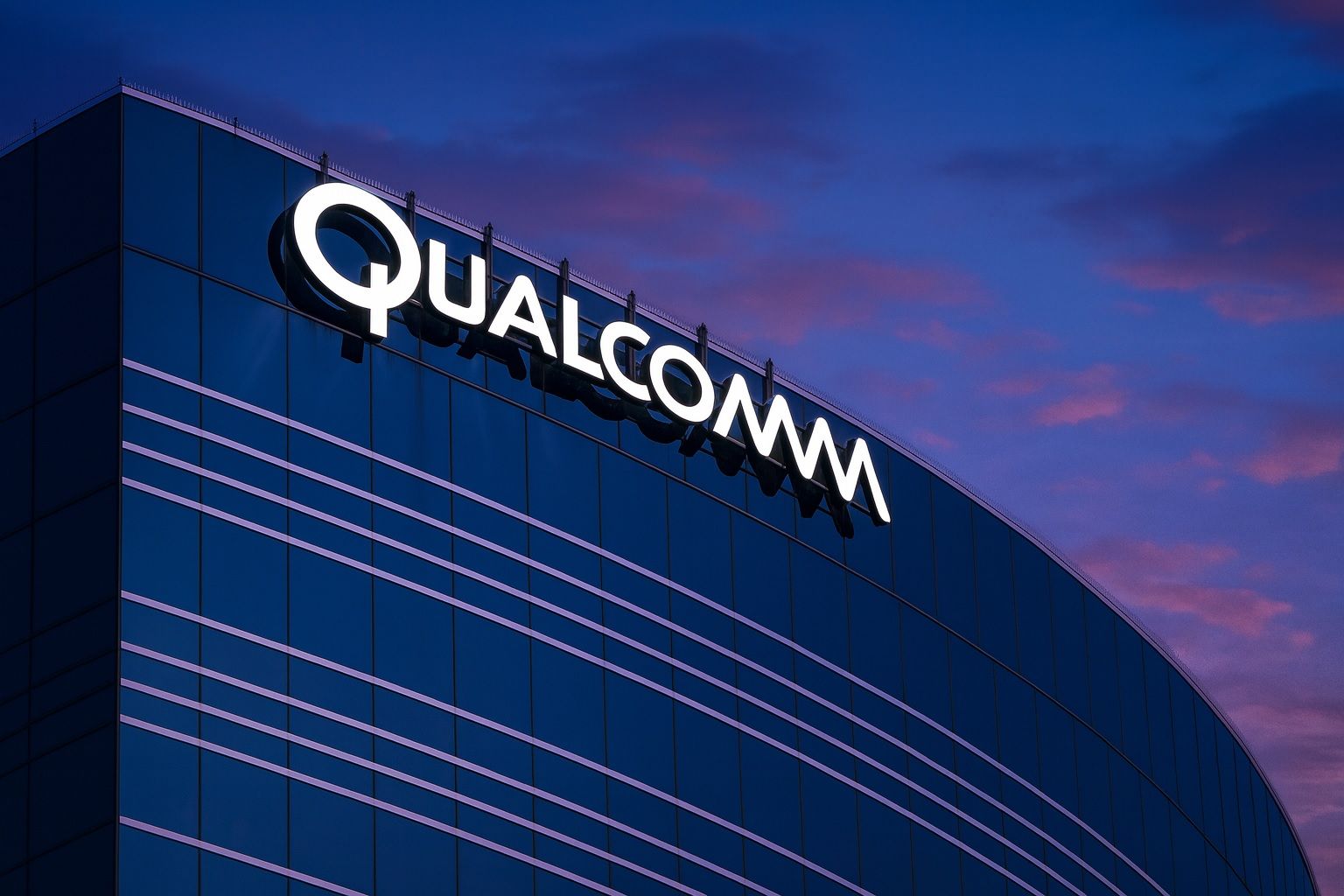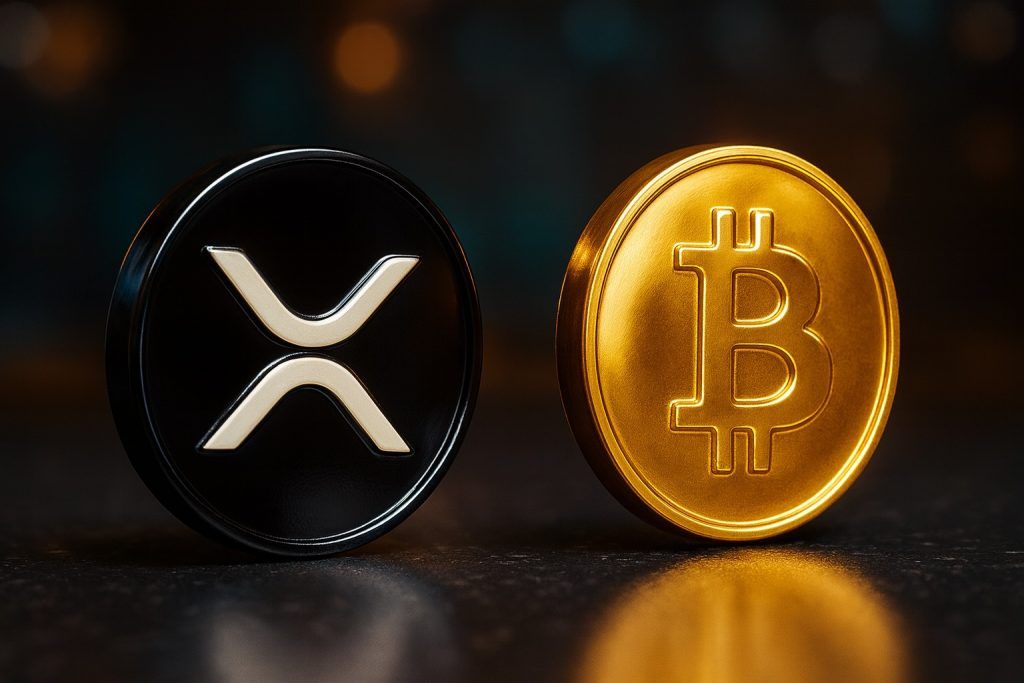- Price & Market Cap: QCOM closed at $165.66 on Oct 9, 2025 [1]. By early pre-market Oct 10 it dipped to ~$161 (–2.2%) [2]. Market capitalization is about $178 billion as of Oct 10, 2025 [3]. (1-year change ≈–4.4% [4].)
- Valuation: Trailing P/E ~15.8 (based on TTM EPS ~$10.47) [5], much lower than peers. For example, forward P/E ~12 vs Broadcom ~31 [6]. Dividend is $3.56/year (≈2.1–2.4% yield) [7] [8], with ~34% payout.
- Financials (TTM): Revenue ~$43.3 B, Net Income ~$11.6 B [9]. Q3 FY2025 (ended June 29) sales were $10.37 B (+10.4% YoY) and EPS $2.77 [10], beating estimates. Qualcomm’s segments: QCT (chipsets) – sells Snapdragon and 5G modems – accounts for most revenue; QTL (licensing) contributed only ~15% of Q3 sales [11] [12].
- Analyst Consensus: About 24 analysts cover QCOM. Consensus is “Moderate Buy” with average 12‑mo target ≈$182–183 [13] [14] (≈10% above current). Long-term EPS growth is forecast ~11–12%/yr [15]. JPMorgan recently raised its target to $200 (overweight) [16].
Recent Stock Performance and News (Oct 2025)
Qualcomm’s stock has been volatile in early October. On Oct 10, it opened sharply lower (≈–2.8%) after China’s regulator announced an antitrust probe into Qualcomm’s planned acquisition of Israeli chipmaker Autotalks [17] [18]. (QCOM shares slid further in pre-market on Oct 10 [19].) Also on Oct 6, a UK court began hearing a £480M ($647M) consumer lawsuit (filed by Which? magazine) alleging Qualcomm forced inflated patent royalties on phone makers [20]. These legal and regulatory risks have grabbed headlines this week.
On the product front, Qualcomm has been busy innovating. At its late-September Snapdragon Summit (Sept 24), QCOM unveiled new Snapdragon X2 Elite PC chips aimed at business laptops. The X2 Elite (and high-end “Elite Extreme” version) are 3nm ARM-based chips, capable of 5.0GHz core clocks and up to 18 cores [21] [22]. Qualcomm says X2 Elite features “Guardian” security (remote management even when a PC is off) [23]. Early benchmark coverage (e.g. TS2.Tech) shows Qualcomm’s own tests with X2 Elite Extreme outpacing Apple’s M4 and top Intel/AMD laptop chips in multi-core and AI workloads [24] [25]. These reports highlight Qualcomm’s push into high-performance PCs and on-device AI (the new Hexagon AI engine delivers ~80 TOPS) [26]. Also, a Reuters report (Oct 1) noted Qualcomm has shifted its flagship chips to ARM v9 architecture to boost AI performance [27].
Meanwhile, broader market news is mixed. Global smartphone shipments grew only about +1% YoY in Q2 2025 [28] (partly due to Apple stockpiling ahead of threatened China tariffs). Demand for 5G chips remains strong overall, but U.S.–China trade tensions linger: U.S. has mostly exempted phones/chips from tariffs [29], yet officials warn semis tariffs could come. Qualcomm’s sales depend heavily on China (as Q3 results noted), so any export controls or regulatory issues there could bite. In summary, recent catalysts include 5G/AI demand and new products on the plus side, but China scrutiny and legal cases on the minus side.
Analyst Commentary & Sentiment
Analysts are cautiously optimistic. J.P. Morgan notes Qualcomm is “executing well” across multiple end-markets, with upsides in handsets, autos and IoT surprising investors [30]. By contrast, TD Cowen warns that licensing revenue loss (e.g. from Huawei) is “another brick to the wall of worry” for QCOM [31]. On valuation, JPMorgan just raised its target to $200 (implying ~26% upside) [32]. By MarketBeat’s tally, analysts are split: 12 Buys, 10 Holds, 1 Sell (consensus “Moderate Buy”) [33], with price targets ranging $140–225 (avg ~$182) [34]. StockAnalysis reports a consensus Buy rating (23 analysts, avg target $183.10) [35].
On fundamentals, Wall Street expects modest growth. A MarketBeat summary noted QCOM’s recent quarter beat estimates (Q3 EPS $2.77 vs $2.71 exp) [36]. Quarterly guidance sees FY2025 Q4 revenue ~$10.3–11.1B and EPS ~$2.79 (midpoint) [37] (slightly below Street). Analysts forecast ~11.5% annual EPS growth over 5 years [38]. JPMorgan believes current valuations leave room to run, pointing out QCOM’s forward P/E (~15) is well below peers (Nvidia ~28, Intel ~32) [39].
Financial Fundamentals
Qualcomm’s financials remain solid. Trailing 12-month revenue ~$43.3B and net income ~$11.6B [40]. In Q3 FY2025 (July ’25), sales were $10.37B (+10.4% YoY) with 26.8% net margin [41]. On a per-share basis, TTM EPS ~10.4 [42] (Q3 was $2.77) gives P/E ≈15.8 [43]. By segment, the chipmaking side (QCT) drives ~85% of revenue, while patent licensing (QTL) is only about 15% [44]. Qualcomm just raised its quarterly dividend 7% to $0.89 (annual $3.56) [45], a ~2.1–2.4% yield [46] [47]. The balance sheet is strong (net cash negative ~$4.8B [48], ~33% payout ratio).
Major products include Snapdragon SoCs (smartphone and PC processors), 5G modems, automotive chips (Snapdragon Auto), and RF/wireless components [49]. (As Qualcomm’s IR describes: its QCT segment “develops and supplies integrated circuits… based on 3G/4G/5G… for use in wireless voice and data communications, networking, computing, multimedia…” [50].) The Snapdragon family remains the core of Qualcomm’s chip sales. Qualcomm also licenses vast patent portfolios (5G/LTE standards), which is a high-margin but shrinking slice of revenue.
Industry & Macro Factors
- 5G Adoption: The global 5G chipset market is growing rapidly. While smartphone unit growth has been modest (~1% in Q2’25 [51]), new 5G rollouts and upgrades (especially in Asia) support Snapdragon sales. Qualcomm benefits as more devices (phones, routers, IoT gadgets) incorporate 5G modems.
- AI & Edge Computing: Qualcomm is pushing “AI PCs” and on-device AI. Its new Snapdragon X2 chips integrate powerful Hexagon NPUs (~80 TOPS) [52] to handle tasks like language agents or vision without cloud servers. This positions QCOM to ride the AI trend in mobile and laptops (vs data-center AI dominated by Nvidia).
- Smartphone Market: Qualcomm’s fortunes are tied to smartphone sales. Trade dynamics have caused volatility – e.g., a brief shipment spike in Q2 as Apple stockpiled iPhones [53]. U.S.–China tensions pose a risk: While semis are mostly tariff-exempt so far [54], new export curbs or subsidies could alter demand. Qualcomm’s large China business is sensitive to such policies.
- Economic Climate: Tech stocks recently have strong momentum (AI hype, potential Fed rate cuts) [55], which could lift QCOM as an established chipmaker. However, valuation comparisons are mixed: analysts note Qualcomm trades cheaper than many tech peers. For instance, Nasdaq/Zacks observes QCOM’s forward P/E (~12) is far below Broadcom’s (~31) [56], implying QCOM is relatively undervalued if growth resumes.
Competitive Landscape
Qualcomm faces stiff competition in each of its markets:
- Broadcom (AVGO): Broadcom dominates network and data-center semis (WiFi, switches, storage). Zacks data show Broadcom’s 2025 revenue up ~21% YoY and EPS up ~36% [57], far outpacing Qualcomm’s ~15% EPS growth. Over the past year, AVGO stock surged ≈+62.5% while QCOM fell ~–30.9% [58]. However, Qualcomm’s valuation remains lower (see above) [59]. Broadcom has also expanded via acquisitions (CA, VMware, etc.), making it a more diversified tech play.
- Nvidia (NVDA): Nvidia is the AI-chip leader. Its stock soared (~171% in 2024) [60], reflecting booming GPU demand. Qualcomm’s business is more modestly growing. Nevertheless, QCOM is trying to capture AI waves on-device. Interestingly, Reuters noted QCOM’s forward P/E (~15) is well under NVDA’s (~28) [61]. Investors may compare the two: Nvidia offers explosive AI growth (but high valuation), whereas Qualcomm offers steady cash flow in mobile/5G (at a lower valuation).
- Intel/AMD: In PCs and servers, Intel and AMD are competitors. Qualcomm’s new laptop chips (Snapdragon X2) directly target Intel Core processors in Windows notebooks. The success of Apple’s M-series has already taken market share from Intel; Qualcomm hopes to win some ARM-based Windows PC share. Note Intel’s stock slumped ~60% in 2024 [62], indicating an opportunity if Qualcomm can make inroads. AMD’s Ryzen CPUs also compete for PC/AI markets. Qualcomm claims its X2 can rival top Intel/AMD chips (benchmarks suggest a lead in multi-thread and AI tasks [63]), though real-world adoption is still unknown.
- MediaTek (2454.TW): In smartphones, MediaTek has become the #1 chipset vendor by volume [64], thanks to dominance in affordable 5G and midrange phones (especially in Asia). Qualcomm still leads in high-end (flagship Snapdragon chips) and maintains strong share in US and Western markets. But MediaTek’s growth in India/China/other markets is a challenge; Qualcomm must emphasize premium features (AI, mmWave 5G) to differentiate.
In short, Qualcomm is more mature and diversified, whereas peers like Nvidia and Broadcom grow faster in niche areas. Analysts often point out that QCOM’s stock has underperformed major competitors (NVDA, AVGO) in the past year [65], but its relatively low valuation and dividend yield attract value-oriented investors.
Partnerships, Legal, and M&A
- Autotalks Acquisition (China Probe): In mid-2025 Qualcomm acquired Autotalks (Israeli V2X automotive chipmaker). Chinese antitrust authorities have now opened a probe into this deal [66], a recent development that could delay integration. (Qualcomm had earlier paused some China licensing due to losing Huawei’s royalties, so regulatory approval is crucial.)
- UK “Which?” Lawsuit: A class-action in London accuses Qualcomm of abusing its dominant patent position to overcharge phone makers (the infamous “no license, no chips” policy) [67]. If plaintiffs prevail, Qualcomm could owe ~£480 M (≈$647 M) in refunds to millions of smartphone buyers. This trial began Oct 7, 2025 and is a reputational/legal headwind.
- Other M&A/Deals: Beyond Autotalks, Qualcomm has not done any massive mergers recently (the old Broadcom acquisition bid collapsed in 2018). It continues partnerships with tech companies: e.g. Microsoft uses Snapdragon in some Always-On PCs, and Qualcomm works with Google on mobile/AI (the new AI PCs sync with Google’s AI stack [68]). On the customer side, Qualcomm still supplies Apple (for e.g. Bluetooth/fm chips in iPhones and baseband in Macs/earbuds), Samsung, Xiaomi, and most Android OEMs (except Huawei). Apple’s shift to in-house modem chips (starting iPhone 16e) will gradually shrink Qualcomm’s modem business [69], but Qualcomm’s CEO says QCOM aims to supply all of Apple’s remaining wireless needs [70].
Outlook
Qualcomm stands at a crossroads. On one hand, it has strong technical leadership (vast 5G IP portfolio, leading-edge chips, broad patent portfolio) and exposure to secular trends (5G, AI, automotive). Its valuation is relatively low, and many analysts expect double-digit long-term growth [71]. On the other hand, it faces near-term headwinds: stiff competition (Broadcom, MediaTek, Nvidia), regulatory/legal risks (China probe, UK suit), and uncertainty over smartphone cycles. Short-term, analysts see only moderate upside (average target ≈$182–183 [72] [73]). Longer-term, Qualcomm’s push into PCs and AI (via Snapdragon X2 chips) could open new growth engines.
In summary, experts are divided: J.P. Morgan calls QCOM’s execution “strong across all aspects of its business” [74], while others warn of licensing “worries” [75]. Investors will watch upcoming catalysts: any easing in China trade/antitrust, Q4 earnings (early Nov), and smartphone demand. If Qualcomm continues to innovate (as recent Snapdragon announcements suggest) and macro conditions stay favorable, some analysts believe the stock could rally from here. At the same time, legal and competitive challenges could cap the upside. As of Oct 2025, the consensus view is cautiously bullish – a “hold/buy” scenario with upside to ~$180–200 if execution stays on track [76] [77].
Sources: Company filings and press releases; Reuters news (Sept–Oct 2025) [78] [79] [80] [81] [82] [83] [84]; MarketBeat/Security analysis [85] [86] [87]; industry commentary (TS2.tech, Nasdaq, etc) [88] [89] [90] [91]. These highlight the latest stock data, analyst quotes, financials, and sector trends.
References
1. stockanalysis.com, 2. stockanalysis.com, 3. stockanalysis.com, 4. stockanalysis.com, 5. fullratio.com, 6. www.nasdaq.com, 7. stockanalysis.com, 8. www.marketbeat.com, 9. stockanalysis.com, 10. www.marketbeat.com, 11. www.reuters.com, 12. www.marketbeat.com, 13. www.marketbeat.com, 14. stockanalysis.com, 15. stockanalysis.com, 16. www.marketbeat.com, 17. www.reuters.com, 18. www.reuters.com, 19. www.reuters.com, 20. www.reuters.com, 21. www.reuters.com, 22. ts2.tech, 23. www.reuters.com, 24. ts2.tech, 25. ts2.tech, 26. ts2.tech, 27. www.reuters.com, 28. www.reuters.com, 29. www.reuters.com, 30. www.reuters.com, 31. www.reuters.com, 32. www.marketbeat.com, 33. www.marketbeat.com, 34. www.marketbeat.com, 35. stockanalysis.com, 36. www.marketbeat.com, 37. www.marketbeat.com, 38. stockanalysis.com, 39. www.reuters.com, 40. stockanalysis.com, 41. www.marketbeat.com, 42. stockanalysis.com, 43. fullratio.com, 44. www.reuters.com, 45. www.marketbeat.com, 46. stockanalysis.com, 47. www.marketbeat.com, 48. stockanalysis.com, 49. www.marketbeat.com, 50. www.marketbeat.com, 51. www.reuters.com, 52. ts2.tech, 53. www.reuters.com, 54. www.reuters.com, 55. ts2.tech, 56. www.nasdaq.com, 57. www.nasdaq.com, 58. www.nasdaq.com, 59. www.nasdaq.com, 60. www.reuters.com, 61. www.reuters.com, 62. www.reuters.com, 63. ts2.tech, 64. www.reuters.com, 65. www.nasdaq.com, 66. www.reuters.com, 67. www.reuters.com, 68. ts2.tech, 69. www.reuters.com, 70. www.reuters.com, 71. stockanalysis.com, 72. stockanalysis.com, 73. www.marketbeat.com, 74. www.reuters.com, 75. www.reuters.com, 76. stockanalysis.com, 77. www.marketbeat.com, 78. www.reuters.com, 79. www.reuters.com, 80. www.reuters.com, 81. www.reuters.com, 82. www.reuters.com, 83. www.reuters.com, 84. www.reuters.com, 85. www.marketbeat.com, 86. www.marketbeat.com, 87. stockanalysis.com, 88. ts2.tech, 89. ts2.tech, 90. www.nasdaq.com, 91. www.nasdaq.com







